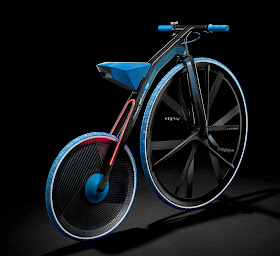 |
| Though fully rideable, the front wheel is only 39-inches diameter, which would seriously limit the "gearing." Proper P-Fars would often have wheels up to 60-inches! (photo from DING3000) |
But that didn't stop designers and engineers from THM-Carbones, BASF, and the design firm of DING3000 from teaming up to create a pair of €50,000 carbon-fiber penny farthings (that's €50,000 each!). Dubbed Concept 1865, the idea was to take the bicycle back 150 years, which apparently coincides with the founding of the chemical/plastic company, BASF. One of the bikes was shown recently at Eurobike 2015.
THM-Carbones is a German manufacturer of carbon fiber cranks and other components, and used their expertise in some of the P-Far's construction, utilizing BASF's latest plastics. And DING3000 apparently came up with the anachronistic design.
 |
| The removable seat hides the battery, which can be charged off the bike. Notice that the bike also has some kind of integrated LED taillight. (photo from DING3000) |
On the other hand, penny farthings had their cranks mounted directly to the front wheel without any kind of "freewheeling" mechanism. They were the original "fixed gear" machines, which meant that going downhill could be a pretty scary experience, or perhaps "thrilling" if a rider had what we might nowadays call "thrill issues." In any case, I haven't found any mention as to whether this little carbon P-Far has any kind of freewheeling action built into that front wheel. If it doesn't, then zipping along on the motor assist would mean the rider's legs would have to spin like crazy to keep up.
 |
| The THM carbon-fiber fork also has a loop of LED lighting. (photo from DING3000) |
Braking duties are taken care of with what appears to be a carbon fiber disc brake on the rear wheel.
Still, the basic design of the penny-farthing, or "ordinary" is it was also known, is such that the possibility of a face plant was all too real and likely -- which is why such things were really nothing more than a quirky-yet-charming dead end in bicycle design. Having a 39-inch front wheel doesn't really change that, other than reducing the falling distance a little. If anyone should actually want to ride the Concept 1865, I'd suggest they avoid hills.
Another tech feature of the bike is the tires, which are some new BASF polyurethane elastomer, and have some kind of expanded polyurethane foam for shock absorption. What is that? Solid tires? So, when they say they're going back to the 1860s, they really mean they're going back. Nevermind that the invention of pneumatic tires in the 1880s remains one of history's all-time greatest transportation-related inventions. The creators also gave the bike some new high-tech pedals that are made entirely of plastic -- without any ball bearings whatsoever. Again, ironically eliminating one of industry's greatest inventions (pioneered on bicycle pedals, of course! Jules Suriray, 1869).
Watch the carbon fiber anachronism in action in this little "image film" available on the DING3000 and BASF websites, or right here courtesy of YouTube.
At €50,000 don't expect to see carbon-fiber P-Fars tooling around near you. But enjoy the video!
As this blog (https://vintagebicycle.wordpress.com/) points out, craftmanship of those XIX century Penny Farthings was so great that even nowadays no CNC machine can replicate the quality of... say, mere bolt or nut that were used in them. We can even left aside talks about extremely tight tolerances that were possible to reach with hand-operated machines but impossible with laser-operated machines from cosmic era. So, given that point it is unclear whether comes the brag? Where's the benefit? I see only lackluster properties and ignorance about how technology in XIX was far worse than today. In fact, in many cases it was genuinely better.
ReplyDeleteAs for Penny Farthing itself, being very beautiful, the whole concept of PF was sheer disaster. It's not a surprise why "safety bicycle" concept killed it so completely and so rapidly, that... good luck to see one in person once in a lifetime.
Still, I'd like to ride one for sole "experience" reason. Just for once. And you know what? That wouldn't be one of those future carbon-made abominations driven by marketing brainz with hipsters as their target audience in mind.
Thank you. DIXI.
This reminds me to request a blurb about racing tricycles old vs new.
ReplyDeleteHmm...Looks like some techies had too much time on their hands...or someone had some grant money that had to be spent.
ReplyDeleteIt's good dissonance marketing, either level A, most people, holding both old fashioned and new fashioned in their minds with novelty connected with the brand, or level B, most readers of this blog, energized by the dissonance or improper usage of a classic design with modern materials to no end except to get you to mention the brand name several times in one post.
ReplyDeleteI guess what you're saying is that, in other words, there's no such thing as bad publicity.
DeletePut simply , it is still a bicycle no matter what anyone says. Kawaii.
DeleteLlewellyn--I agree. And I wouldn't mind trying it just for fun. No way, though, I'd pay 50,000 Euros (if I had that much to spare) for it.
Delete